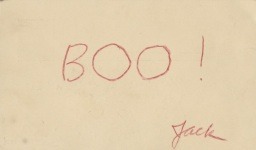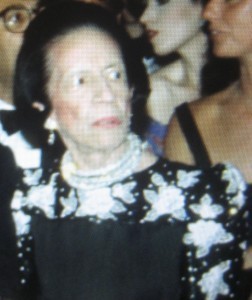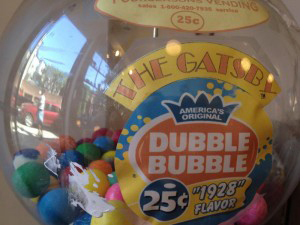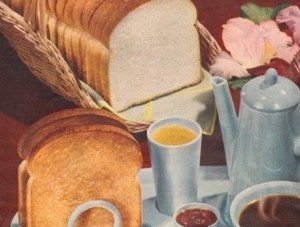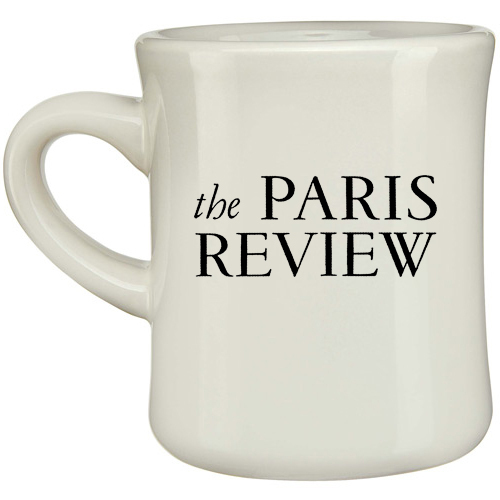The Paris Review's Blog, page 887
September 18, 2012
Beat Letters, Literary Ink
Check out this letter from Jack Kerouac to his editor, in which the Beat presses for publication of On the Road.
Librarians with literary tattoos!
While we’re at it, writers in underpants. (No exclamation mark.)
Books You’ve Never Heard of By Authors You Have. (Spoiler: you may have actually heard of a few of them, but you get the idea.)
“An audio version [of Gravity’s Rainbow] does exist, though it came from the time of cassettes, not MP3s. The book was recorded in 1986 by George Guidall … it runs to 34 hours.”
September 17, 2012
Immoderation: On Sharing an Idol
Diana Vreeland. Photograph by Mary Hilliard.
Last year, I was given the birthday gift of a lifetime: I got to spend the occasion with Diana Vreeland. A friend, who has long been close with the Vreeland family, took me on a weeklong pilgrimage to the Marrakech home of one of Vreeland’s sons. Our hosts, aware of my longstanding obsession with Diana, settled me into what is alternately known as the “D.V. Room” and the “T.V. Room,” for it boasted a rather ancient television set that looked like it might electrocute anyone who dared near it. Above it hung the splendid William Acton portrait of Vreeland that graced the first edition of her memoir, D.V. (edited, incidentally, with gusto by Paris Review cofounder George Plimpton). The painting lovingly depicted her trademark red talons, lacquer-black hair, and the leather thong sandals she claimed to have had recreated from those donned by a slave perfectly preserved (in coitus, no less) by the ashes of Vesuvius. For Vreeland, inspiration came from the most unlikely of sources.
The local souk held countless wonders for the other houseguests, but the sprawling, glamorously disheveled Vreeland house engrossed me far more. The D.V. imprint was everywhere. First of all, nothing quite made sense—at least to the orderly, pedestrian mind. You had to resign yourself to wandering the labyrinth and surrendering to the various unexpected delights along the way, such as a turret room festooned entirely with leopard print, or a dark hidden library, filled with hundreds of Vreeland’s books, many (if not most) of which had been inscribed to her by their authors. In yet another room stood one of her famed Louis Vuitton traveling trunks, her initials D.D.V. emblazoned in imperial red ink on one side. One evening, after too many bottles of Moroccan wine, our party took a vote and elected to open it up. The candles in the room blew out as we lifted the lid. Vreeland was clearly present—and making it known that she could only tolerate so much reverential curiosity.
Freak, Memory
Art from the film poster for Where Eagles Dare.
The half-mouse—the good half, the half equipped with a smell memory validated by neuroscience, the half mortally known as the half that never saw it coming—shot across the kitchen floor, headed due west with a decent but final glimpse of the front yard. The back half landed somewhere near the sink.
My brother had split the mouse in two with a nine-iron. According to witnesses at the scene, the creature’s separation was cartoonishly neat. I recall thinking this was a flawed method of pest control for someone with no short game to speak of. The linoleum gopher hump that rose from my grandparents’ kitchen floor—a distortion from water damage—did place the moment in a Goony Golf warp. But from my understanding, the murder was more reflex than act of cruelty. It wasn’t like my brother teed up and put the mouse through a window. (I imagine a similar instinct overtaking him the time he allegedly potato-slammed a palmetto bug on the kitchen counter, knocking it out of its exoskeleton, quivering.) He just grabbed the first thing within reach—a legendary chemistry teacher’s nine-iron—and let the mouse have it. Having once hurled a toaster oven at a cockroach, I can relate.
Rejection, Crime, and Gum
The three types of stories one editor always rejects.
Meet the Agency Review, devoted to books on advertising.
The short, strange story of Gatsby gumballs.
Oh, dear. An (allegedly) disgruntled author was taken into custody after (allegedly) attacking a San Francisco literary agent.
A school project we wish were real.
“It was George Orwell’s golden-eyed toad that made me a writer.” Simon Schama on literary inspiration.
September 14, 2012
What We’re Loving: Kim’s Video, Grant’s Memoirs
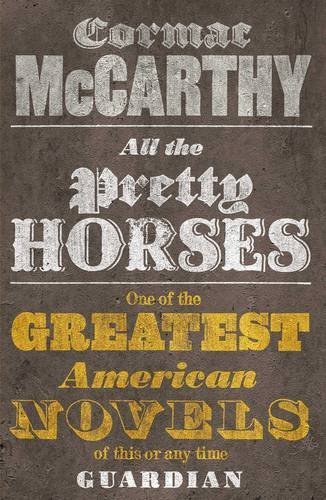 Even if you've never read a book about the Civil War, the Personal Memoirs of U.S. Grant will grip your imagination. Dictated by Grant on his deathbed, championed and published by Mark Twain, celebrated by Matthew Arnold and Edmund Wilson (who compared it to Walden and Leaves of Grass), the Memoirs were cited by Gertrude Stein as a main influence on her own prose. However you may write, you'll find their power is contagious. Every page is a lesson in force, clarity, and grace under pressure. To read Grant’s description of a military problem, then to read the orders he gave, is, among other things, to see a great modern writer at work. —Lorin Stein
Even if you've never read a book about the Civil War, the Personal Memoirs of U.S. Grant will grip your imagination. Dictated by Grant on his deathbed, championed and published by Mark Twain, celebrated by Matthew Arnold and Edmund Wilson (who compared it to Walden and Leaves of Grass), the Memoirs were cited by Gertrude Stein as a main influence on her own prose. However you may write, you'll find their power is contagious. Every page is a lesson in force, clarity, and grace under pressure. To read Grant’s description of a military problem, then to read the orders he gave, is, among other things, to see a great modern writer at work. —Lorin Stein
Have you ever imagined a music video as you listen to a song? Sigur Ros asked a dozen filmmakers to do just that with songs from their new album. The results are pretty great, but my favorite—and I’m hardly impartial—is Dash Shaw’s animated (I mean that literally) take on “Valtari.” Penned with Shortbus and Hedwig writer John Cameron Mitchell, the video features backgrounds by Frank Santoro, whose colors are, as ever, divine. —Nicole Rudick
If you’re in agreement with a friend of mine who considers most recent American covers of Cormac McCarthy’s novels “oversaturated Windows wallpapers” (why yes, Cormac, that horse is very pretty), then perhaps you will be both pleased and envious to know that the British ones now look like this, and apparently have for some time. Thanks to the now-defunct Aesthetic Book Blog for this gritty eye candy. And check out The Millions’ annualish comparison of American and British book covers for further contemplation. —Samuel Fox
“Thule, the Period of Cosmography”: An Illustrated Panorama
This anonymous love lyric about the polar regions was set to a madrigal by the composer Thomas Weelkes in 1600. Four hundred years ago, poets had the luxury of looking at the horizon and marveling at what might lie beyond it. We’ve since lost that hopeful curiosity about the external world. The natural wonder of volcanic eruption is now classified as a natural disaster, and the once romantic Andalusian merchant is now seen as a capitalist pig. Having run out of physical space, exploration has turned inward. Thule is now the period of an interior cosmography. We go there not as heroes, but as a collection of anonymous users.
The point of the poem—and I think it endures—is that the commonplace grime and dirt of our own feelings is still more powerful and exciting than the Thule of either cosmography.
September 13, 2012
Dead Authors at Fashion Week: Part 2
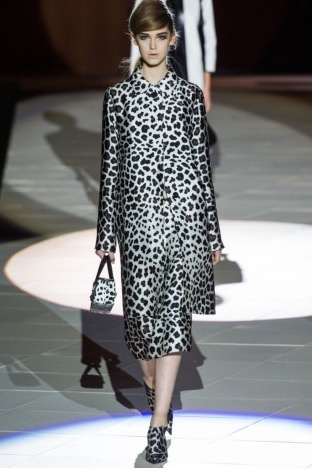 Ernest Hemingway goes hunting at the Marc Jacobs Spring 2013 show.
Ernest Hemingway goes hunting at the Marc Jacobs Spring 2013 show.
I am in range and my hat, which is in this season, is good and on, a damn cute hat, and I can see the entire show and the open runway, which is showing fashion. Afterward, Marc, who is an American man who can wear a skirt and make it look good, will throw a party. Open bar.
There she is. That’s a damn fine one, too. The spots are fine, and her hair parts in a fine way, and the dress hangs low and true and near the floor, within the finery.
It’s as dark as if it wasn’t light. I could shoot, aim, and get my shot. But then there’s the crowd. Well, the crowd. Yes, the crowd. Hm, the crowd.
Come on. Shoot. She’s not going to stand there all day and it’s already dark and in the darkness I can see the next one emerging.
Hell, is it a worthwhile head? She’s a small target with a small face and what if the dress got marked? It’s Marc Jacobs, which is too good. Which is too good.
Small, Good Things
One of Mary Oliver’s poems begins “Something has happened / to the bread / and the wine.” A most unusual mystery, the comestibles have not gone the way of the plums in William Carlos William’s “This Is Just to Say.”
Oliver’s wine and bread, as she explains in the second stanza, “have been blessed.” These two central elements of the Christian faith have been lifted from their ordinariness, isolated in order to show the extraordinariness of even the most ordinary of things. The bread and the wine join water and words to become what believers call sacraments: Eucharist is a sacrament made from staple food and festive drink; baptism is a sacrament made of clean, clear water.
One way of understanding the sacraments, perhaps best articulated by liturgist Gordon Lathrop, is that simple things become central things. When Christians refer to the bath and the table, they refer not only to the specific sacraments of bathing and eating, but they point also to the sacramental character of every bath and every table. The setting apart of one table and one bath shows forth the splendor of all tables and all baths.
That setting apart is the calling of Christians but also the vocation of the writer. Read More »
Announcing Our New Mug!
A year after our café au lait cup sold out, we’re pleased to announce the arrival of its sturdy American cousin, the diner mug—perfect for keeping your coffee or tea warm while you read Ottessa Moshfegh’s tale of doomed love in a Chinese boomtown or Roberto Calasso on possession, sacrifice, and his resemblance to Groucho Marx.
One side displays our classic logo. The other side (not pictured here) gives a fair and up-to-the-minute assessment of the magazine you love: “The first really promising development in youthful, advance guard, or experimental fiction in a long time. —Newsweek, 1953 ”
This straight-talking mug is yours with a one-year subscription or renewal. Order now!
Offer good for U.S. addresses only.
September 12, 2012
Stage Struck
Most of what I read about professional tennis, particularly the profiles of the game’s biggest names, appears around the Grand Slams, three of which are played over the summer here in the northern hemisphere. This was the summer of Roger Federer, Andy Murray and his new coach Ivan Lendl, and Venus and Serena Williams. Novak Djokovic, the world’s top men’s player when the summer began, had had his moment in Vogue in May 2011, during a season when, at one point, he’d string together forty-three straight victories and lose only six matches.
Near the end of that season, about a month after Djokovic saved two match points against Federer’s serve to win their U.S. Open semifinal, the New York Times Magazine ran an essay by Adam Sternbergh called “The Thrill of Defeat.” The occasion for the piece was the “278 million to 1” odds against the Boston Red Sox’s “epic” collapse during the 2011 pennant race. To a Federer fan looking back to the Open, though, those odds seemed about right. What also seemed right were Sternbergh’s thoughts about the basic absurdity of sports and, my affinity for Bart Giamatti notwithstanding, the “terrible sportswriters” who “argue that sports are a grand metaphor, a stage on which we witness essential narratives about determination, bravery and heart.” Read More »
The Paris Review's Blog
- The Paris Review's profile
- 305 followers


